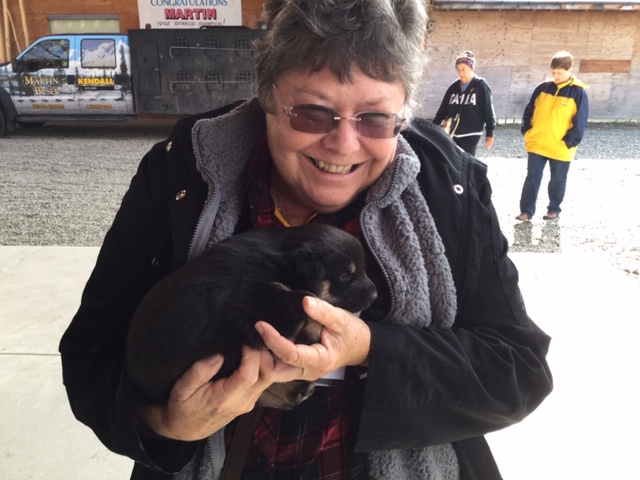
The temperatures were hovering around 100 degrees in Tennessee, but I was shivering in a long-sleeved shirt, a vest and a jacket. While my friends at home stayed indoors in September to escape the heat, I was exploring the vast wilderness and beauty of Alaska in 55-degree weather.
At the end of September, the northernmost state was in a state of preparation for winter. Life in the 49th state is unlike anything we experience in the lower 48. Winters are harsh, with 20 – 60 days of snow, average snowfalls around 75 inches and temperatures reaching 40 and 70 degrees below zero in some regions. And while we complain about the shorter days in the winter in Tennessee, Alaskans only see a few hours of daylight with the top edge of the sun barely touching the horizon. They live the other 20 hours a day in darkness. It’s no wonder that by October 1st many residents flee the cold and head to more daylight and forgiving climates further south.
Those hearty folks who stay through the winter have learned to thrive in sub-zero darkened days. In the outback or wilderness heat, food and transportation are not conveniences, they’re essential for survival. And while there may be electricity (though not always), good luck finding a television station, the internet or even cellphone service!
Historically, one of the most reliable ways to travel in Alaska in the winter is with dog sleds. Used by the native people for centuries, dog sledding caught the world’s attention when an epidemic of diphtheria broke out in Nome, Alaska, one of the remotest towns in the world. Life-saving serum was shipped to the coastal city of Seward and carried inland by train to Nenana in central Alaska. However, because of the severe weather, the only way to deliver the medicine the rest of the way was to use the traditional and reliable dog sleds. Twenty mushers (those are the guys driving the sleds) with over 150 dogs relayed the serum 674 miles across some of the coldest and harshest terrains on the earth in five and a half days.
This superhuman feat became the inspiration for the now-famous annual 1049-mile Iditarod Trail Dog Sled Race from Anchorage to Nome held each year on the first Saturday of March. The mushers and their 12-16 member dog teams race against each other and the harsh arctic conditions including blizzards, gale-force winds and temperatures with a wind chill reaching 100 degrees below zero.
Unlike the bulky Siberian huskies, Alaskan huskies are smaller and leaner. These 60-pound energetic dogs love the cold weather and they love to run. When the musher hooks them to their harnesses, they bark and bounce in jubilation, like excited children at Disney World. When the musher releases the brake and says, “Hike!” they bound forward like racehorses bursting out of the starting gate. These dogs love their work!
We visited the home and training center of one Iditarod champion where we got to hold some two-week-old husky pups. They were the sons and daughters of sled-pulling race-winning athletes. In their bloodline, these young-uns had the potential to become the world-class runners already built into them. All they needed was a little training, discipline and direction.
Training begins shortly after the pups are born with lots of loving and handling. The newborns quickly form a bond with their trainer and follow him everywhere. He gradually introduces obstacles for the dogs to overcome and gives lavish praise when the pups succeed. When they’re old enough, they begin wearing a harness and learning to pull. Next, the dogs are taught to listen for the commands: Hike! (Let’s go), Haw! (Turn left), Gee! (Turn right), Easy! (Slow down), and Whoa! (Stop). Young dogs are paired with older ones who become their mentors. Each pup is a potential champion.
Every one of us is born with championship potential, too. God created us with a personalized set of natural-born gifts—built right into our DNA. Whether it’s running, working with numbers, humor, an understanding of machines or plants, playing an instrument, working with wood or fabric, or playing with animals, the gift is in us. Sometimes it’s buried deep and we have to go soul searching to find it. Other times it’s right there on the surface for everyone to see.
We’ve all heard the phrase, “Find a job doing what you love and you’ll never work a day in your life.” While many of us find that perfect fit in our professions, others discover our gifts in our hobbies or our free time. When we’re operating in our gifting, we’re happy and can’t wait to get to work, like the Alaskan huskies.
However, potential alone won’t make us champions. We need discipline and training to fine-tune our gifts into something worth displaying. David was born with the gift of writing songs and playing the harp. But he didn’t rely on his natural ability. He practiced before an audience of sheep until he learned to play skillfully on the 10-string lyre.
God has given us all we need for fulfillment and success. Like these Alaskan huskies, we have the potential is built into each of us. If you haven’t discovered your gift yet, ask God to show you. If you know your gift, keep on training. There’s always room for improvement. God wants each of us to find our perfect fit so we can live up to our fullest potential.
God’s saying, “Hike!” to you and me, so let’s slip into our harnesses and start running! There’s a race to win.

Beautifully written, M.J.! Prayers that y’all are doing well since we went on the water part of the trip.
Hi Jane,
Yes, we’re busy as bees! I know you had a great trip. Glad you enjoyed the post.
This is beautiful and inspiring, Mary Jane!
Thanks, Charity.